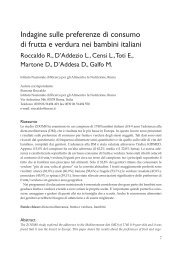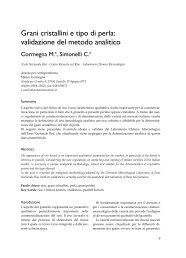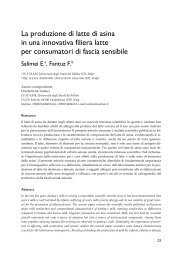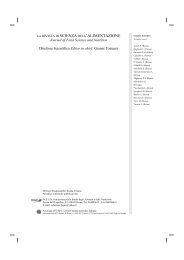The colour, bitterness and aroma of l'Aquila DOP saffron - FOSAN
The colour, bitterness and aroma of l'Aquila DOP saffron - FOSAN
The colour, bitterness and aroma of l'Aquila DOP saffron - FOSAN
Create successful ePaper yourself
Turn your PDF publications into a flip-book with our unique Google optimized e-Paper software.
Practical applications<br />
10<br />
LA RIVISTA DI SCIENZA DELL’ALIMENTAZIONE, NUMERO 4, OTTOBRE - DICEMBRE 2010, ANNO 39<br />
It is important for producers <strong>and</strong> users <strong>of</strong> L’Aquila<br />
<strong>DOP</strong> <strong>saffron</strong> that the equilibrium between<br />
<strong>colour</strong>, <strong>bitterness</strong> <strong>and</strong> <strong>aroma</strong> that has made this<br />
<strong>saffron</strong> so appreciated throughout the world is<br />
maintained. With the ancient traditions for its<br />
production passed down from father to son, the<br />
<strong>saffron</strong> growers need to continue to follow these<br />
processing technologies. To be sure <strong>of</strong> this, there<br />
is the need to define <strong>and</strong> monitor the specific<br />
characteristics that are typical <strong>of</strong> the L’Aquila<br />
<strong>DOP</strong> <strong>saffron</strong>. <strong>The</strong> present study provides such a<br />
monitoring process. Here, the combination <strong>of</strong> the<br />
<strong>colour</strong>, <strong>bitterness</strong> <strong>and</strong> <strong>aroma</strong> characteristics (the<br />
Z variable) <strong>of</strong> L’Aquila <strong>DOP</strong> <strong>saffron</strong> over the fiveyear<br />
period from 2005 to 2009 are shown to vary<br />
according to climate <strong>and</strong> growing conditions, indicating<br />
that the ancient processing technologies<br />
<strong>of</strong> this L’Aquila <strong>DOP</strong> <strong>saffron</strong> are indeed being<br />
respected. Similar future monitoring are needed<br />
to confirm that this situation is maintained.<br />
Introduction<br />
<strong>The</strong> <strong>saffron</strong> from L’Aquila (Abruzzo, Italy) is<br />
recognised as a protected designation <strong>of</strong> origin<br />
(<strong>DOP</strong>) according to EU Regulation N° 2081 <strong>of</strong><br />
2001 (Government Decree, 2003). <strong>The</strong> zone that<br />
comprises the thirteen boroughs <strong>of</strong> the L’Aquila<br />
province has been <strong>of</strong>ficially recognised as the<br />
protected production area. This zone is located at<br />
an altitude <strong>of</strong> between 350 m <strong>and</strong> 1,000 m above<br />
sea level, <strong>and</strong> it extends over two plateaus: Navelli<br />
<strong>and</strong> Prada d´Ansidonia.<br />
<strong>The</strong> <strong>saffron</strong> produced in this area <strong>of</strong> L’Aquila<br />
is obtained from the dried stigma <strong>of</strong> the Crocus<br />
sativus L. plant, a cultivated species <strong>of</strong> crocus that<br />
belongs to the Iridaceae family. <strong>The</strong> C. sativus<br />
from which this <strong>saffron</strong> <strong>DOP</strong> is obtained is cultivated<br />
as follows: the cultivated soil (rotated<br />
every 5 years) is prepared by ploughing to a<br />
depth <strong>of</strong> 30 cm <strong>and</strong> applying organic fertilisers;<br />
the flower-beds are laid in furrows that are 2 cm<br />
to 4 cm deep <strong>and</strong> set from 20 cm to 25 cm apart;<br />
the planted bulbs are picked in mid-August, with<br />
the collection <strong>of</strong> the flowers <strong>and</strong> the successive<br />
processes carried out by h<strong>and</strong>; preservation <strong>of</strong><br />
the finished product is obtained by drying over<br />
almond, olive or oak charcoal using a sieve, for a<br />
time that varies according to the depth <strong>of</strong> the<br />
layer <strong>of</strong> <strong>saffron</strong>. <strong>The</strong> drying phase during which<br />
the fragrant element <strong>of</strong> the <strong>saffron</strong>, safranal, develops<br />
is essential (Tammaro <strong>and</strong> Di Francesco,<br />
1978; Massimini, 1980; Piccioli, 1932).<br />
<strong>The</strong> main components <strong>of</strong> <strong>saffron</strong> are crocin,<br />
which is responsible for the characteristic <strong>colour</strong>,<br />
the glucoside picrocrocin, <strong>and</strong> safranal. Crocin is<br />
the digentiobiose ester <strong>of</strong> the carotenoid crocetin:<br />
the trans-crocetin di-(β-D-gentiobiosyl) ester.<br />
Crocetin itself is a conjugated polyene dicarboxylic<br />
acid that is hydrophobic, <strong>and</strong> thus oil soluble.<br />
Picrocrocin is responsible for the <strong>saffron</strong><br />
<strong>aroma</strong>, <strong>and</strong> from this the safranal component is<br />
derived. Safranal is the principal component <strong>of</strong><br />
the essential oil, with its characteristic scent, <strong>and</strong><br />
thus represents the odour aspect. Safranal is only<br />
formed from the picrocrocin at a late stage during<br />
the toasting <strong>and</strong> storage <strong>of</strong> the finished product.<br />
<strong>The</strong> heat, combined with enzymatic action,<br />
splits picrocrocin to yield D-glucose <strong>and</strong> a free<br />
safranal molecule (Amelotti <strong>and</strong> Mannino, 1977;<br />
Corradi <strong>and</strong> Micheli, 1979a, b; ISO3632 (1), 2003;<br />
ISO3632 (2), 2003).<br />
With the aim <strong>of</strong> characterising the L’Aquila<br />
<strong>DOP</strong> <strong>saffron</strong>, we carried out an investigation into<br />
these chemical components. This will also allow<br />
better differentiate <strong>of</strong> this L’Aquila <strong>DOP</strong><br />
<strong>saffron</strong> from <strong>saffron</strong> produced in other areas<br />
across Italy <strong>and</strong> abroad, with particular regard<br />
to its <strong>aroma</strong>, as its most distinctive <strong>and</strong> recognised<br />
characteristic.<br />
Materials <strong>and</strong> Methods<br />
Samples<br />
Two hundred <strong>and</strong> thirteen <strong>saffron</strong> samples from<br />
the Navelli <strong>and</strong> Prata D’Ansidonia plateaus were<br />
obtained in the period from 2005-2009. <strong>The</strong> analyses<br />
for the chemicals crocin, picrocrocin <strong>and</strong> safranal<br />
was carried out according to Corradi et al.<br />
1979b, <strong>and</strong> performed according to the schemes<br />
suggested by UNI CEI EN ISO/IEC 17025:2005.







